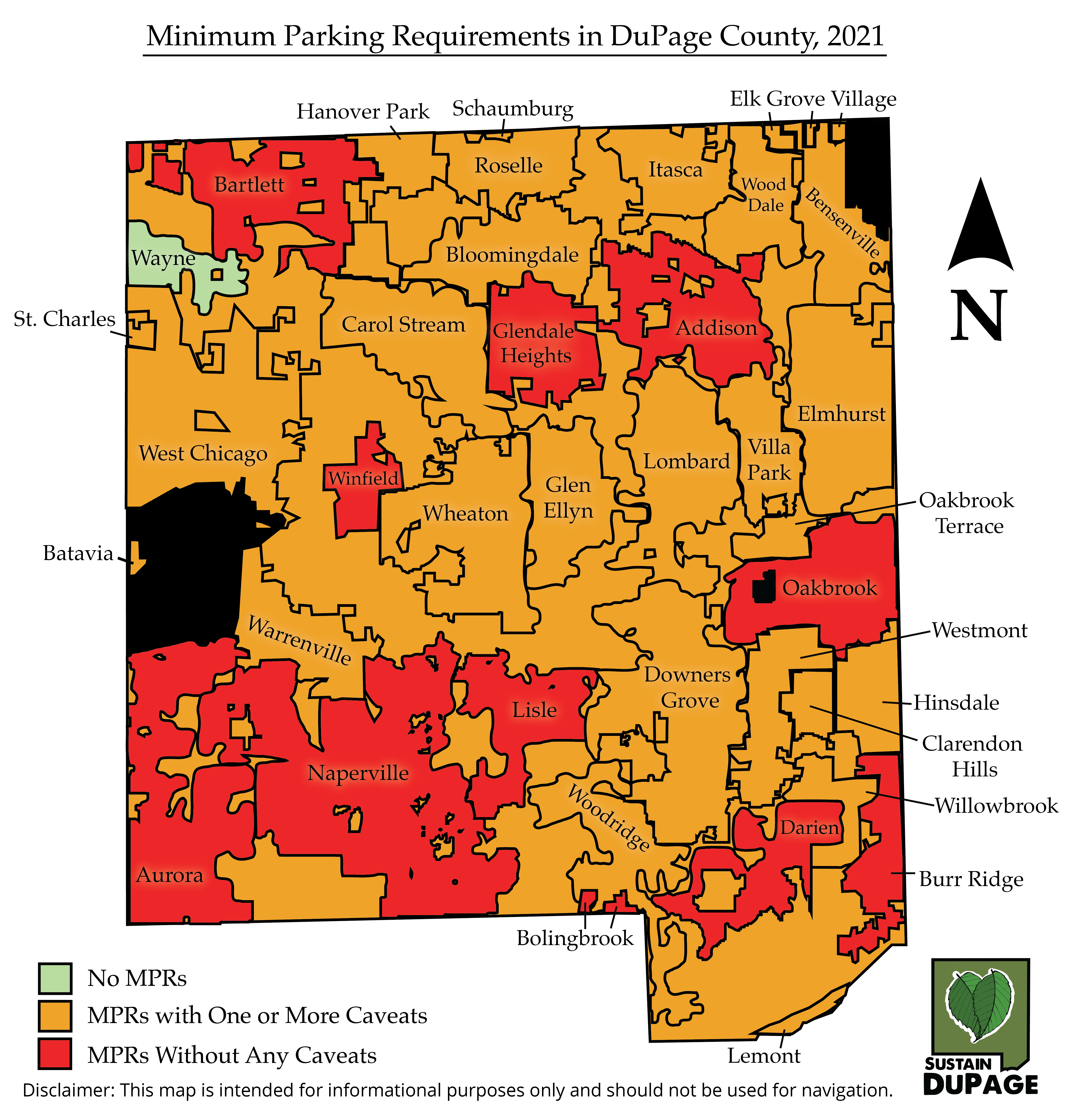DuPagers Organized For:
Parking Reform
Because sustainability is a human right.

Special thanks goes to Captain David T. Weaver, who focused his (Prescott College) Master of Science in Resilient and Sustainable Communities Capstone project on parking reform in DuPage County. Your research has launched an entirely new resource for the DOFS project- thank you!

What Are Minimum Parking Requirements?
Minimum Parking Requirements (MPRs) are zoning ordinances that legally require business owners to build and maintain a minimum amount of parking spaces for their establishments.
Why are Minimum Parking Requirements Regressive?
They harm the local economy: By requiring business owners to build and upkeep a certain amount of parking spaces, we increase construction costs and reduce the amount of capital that can be invested into the rest of the building. Parking construction costs alone add 30% to the cost of the average office building as the average above ground parking space costs $29,000 in the Chicago area. In addition, MPRs reduce the tax base. Land used for parking produces only 40% of the tax revenue that land used for buildings do on average, and subsequently cities with the greatest increase in parking experience a gradual decrease in their property tax base. Parking lots are also just plain ugly. Parking spaces discourage businesses and residents from wanting to locate, walk, and shop nearby.
They harm our ecosystem: The added costs of building unecessary parking spaces lead developers to build in low-density areas where cheaper land allows surface parking, and thus MPRs don’t just lead to sprawl but they incentivize it. Additionally, these financial and opportunity burdens lead developers to build less dwelling units on the same lot space in order to reduce their minimum parking requirements, incentivizing larger and more expensive apartments, and in the end reducing the number of dwelling units built. MPRs also drastically and unnecessarily expand impermeable surfaces which contribute to flooding and wastewater overflow, posing public health risks, devaluing property, and possibly even causing infrastructure damage. Parking lot runoff increases by as much as 900% when compared to pre-development hydrology.
They harm our human community: In the end, MPRs, and the sprawl to which they contribute, exacerbate housing shortages and reduce affordable housing. By catering to cars in our business districts we are shooting ourselves in the foot- because science shows that businesses receive higher foot traffic when municipalities prioritize public transit, complete streets, bicycle parking, valet parking, municipal parking lots, carpooling programs, etc.
What Reform is Needed to Fix the Problem?
We need to eliminate Minimum Parking Requirements (MPRs). This would allow businesses and developers to build as much parking as they believe they need without being forced to build extra parking spaces that they don’t need.
Potential Alternatives:
There are several effective methods for managing and reducing parking demand. These alternative methods should not be assumed to be an easy switch from MPRs. All of these alternatives would require further assessment as each community will need to assess their real parking requirements and which alternative methods will work best for their residents. There are tradeoffs to each of these alternatives and each one will require in depth analysis, potentially a pilot program, and careful implementation.
Time Limits and Smart Metering. On-street smart parking meters that adjust parking prices to maintain a 90% fill rate ensure there is always parking available, encourages customer turnover, and discourages all-day employee parking, supporting a vibrant business climate.
Parking Permits. Parking permit zones for residents prioritize adequate curb space for residents in the neighborhood while limiting the demand for separate parking for each lot as there is a common pool for parking.
In-Lieu Parking Fees. Developers can pay a fee to either reduce their parking requirements from the minimum requirements or to expand parking beyond the maximum parking regulations. This fee will discourage lots from going beyond the parking maximums while raising funds for shared public off-street parking or for bicycle lanes, trails, and public transportation.
Bicycle Lanes, Trails, and Public Transportation. All funds collected from smart metering and parking permits should be directed towards visible community improvements. This maintains public support for the programs and can work to further manage and reduce the demand for parking by funding bicycle lanes, trails, pedestrian infrastructure, and public transportation. The existence of aesthetically pleasing landscaping can improve the happiness of residents and decrease parking demand by making walking a more pleasant option.
Parking Maximums. Whereas MPRs require a development to build at least a minimum amount of parking, maximum parking regulations limit the amount of parking that can be built on a lot without an approved variance. Maximum parking regulations can also benefit lot developers through transferable parking entitlements that allow owners to sell or rent out their parking spaces to other developments if their own parking spots are not needed.
Peer Models:
Bensenville, IL. In 2018, Bensenville eliminated MPRs as a part of a routine update for non-residential uses in their downtown district, and instituted maximum parking regulations, reductions of MPRs for proximity to transit or municipal parking lots, reductions of MPRs for having electric vehicle charging stations, car share parking, and allowed for land-banked parking or fees-in-lieu of providing parking spaces. This has provided the city significant negotiating power for the few requested variances for more parking. Additionally, according to Kurtis Pozsgay, the Senior Planner with Bensenville’s Community and Economic Development department, there have been several developments built because the new parking laws are supportive. One example is a downtown mixed-use building that is currently home to two commercial units, one warehouse, and ten dwellings. Because of the new parking requirements, only ten spaces for the ten dwellings were required, and the developer was able to reduce the requirement to six by leasing four spaces from the nearby municipal parking lot. This mixed-use building has been a boon for the downtown, and now there are several similar projects in development.
Downers Grove, IL. Downers Grove updated their Zoning Ordinance in 2014 to include maximum parking regulations and to allow non-residential developers to reduce their MPRs due to proximity to transit or municipal parking lots, pay a fee-in-lieu of building a parking space, or land-bank parking. They made these updates as their zoning ordinance had not been comprehensively reviewed in many years and their parking policies did not reflect best practices. According to Stan Popovich, the Director of Community Development for Downers Grove, this has reduced the amount of parking built, saved developers time and money, allowed and encouraged reinvestment on small lots that otherwise would not have happened, and has faced zero opposition or complaints.
Do You Want to Help Your Community Remove Minimum Parking Requirements?
Reference Materials
If you are planning to begin organizing around removing MPRs in your community, please let us know how we can support you in your efforts.